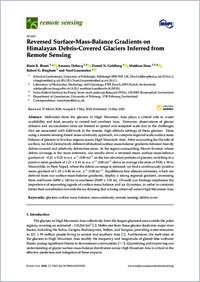Reversed surface-mass-balance gradients on himalayan debris-covered glaciers inferred from remote sensing
- Bisset, Rosie R. School of GeoSciences, University of Edinburgh, Edinburgh EH8 9XP, UK
- Dehecq, Amaury Laboratory of Hydraulics, Hydrology and Glaciology, ETH Zurich, 8093 Zurich, Switzerland - Swiss Federal Institute for Forest, Snow and Landscape Research (WSL), CH-8903 Birmensdorf, Switzerland
- Goldberg, Daniel N. School of GeoSciences, University of Edinburgh, Edinburgh EH8 9XP, UK
- Huss, Matthias Laboratory of Hydraulics, Hydrology and Glaciology, ETH Zurich, 8093 Zurich, Switzerland - Swiss Federal Institute for Forest, Snow and Landscape Research (WSL), CH-8903 Birmensdorf, Switzerland - Department of Geosciences, University of Fribourg, 1700 Fribourg, Switzerland
- Bingham, Robert G. School of GeoSciences, University of Edinburgh, Edinburgh EH8 9XP, UK
- Gourmelen, Noel School of GeoSciences, University of Edinburgh, Edinburgh EH8 9XP, UK
-
14.05.2020
Published in:
- Remote Sensing. - 2020, vol. 12, no. 10, p. 1563
English
Meltwater from the glaciers in High Mountain Asia plays a critical role in water availability and food security in central and southern Asia. However, observations of glacier ablation and accumulation rates are limited in spatial and temporal scale due to the challenges that are associated with fieldwork at the remote, high-altitude settings of these glaciers. Here, using a remote-sensing-based mass-continuity approach, we compute regional-scale surface mass balance of glaciers in five key regions across High Mountain Asia. After accounting for the role of ice flow, we find distinctively different altitudinal surface-mass-balance gradients between heavily debris-covered and relatively debris-free areas. In the region surrounding Mount Everest, where debris coverage is the most extensive, our results show a reversed mean surface-mass-balance gradient of −0.21 ± 0.18 m w.e. a−1 (100 m)−1 on the low-elevation portions of glaciers, switching to a positive mean gradient of 1.21 ± 0.41 m w.e. a−1 (100 m)−1 above an average elevation of 5520 ± 50 m. Meanwhile, in West Nepal, where the debris coverage is minimal, we find a continuously positive mean gradient of 1.18 ± 0.40 m w.e. a−1 (100 m)−1. Equilibrium line altitude estimates, which are derived from our surface-mass-balance gradients, display a strong regional gradient, increasing from northwest (4490 ± 140 m) to southeast (5690 ± 130 m). Overall, our findings emphasise the importance of separating signals of surface mass balance and ice dynamics, in order to constrain better their contribution towards the ice thinning that is being observed across High Mountain Asia.
- Faculty
- Faculté des sciences et de médecine
- Department
- Département de Géosciences
- Language
-
- English
- Classification
- Hydrology
- License
- License undefined
- Identifiers
-
- RERO DOC 328834
- DOI 10.3390/rs12101563
- Persistent URL
- https://folia.unifr.ch/unifr/documents/308705
Statistics
Document views: 129
File downloads:
- hus_rsm.pdf: 167
